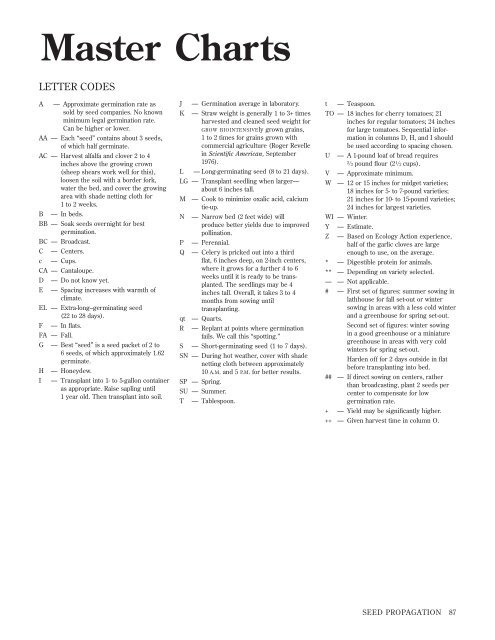How to Grow More Vegetables : And Fruits, Nuts ... - Shroomery
How to Grow More Vegetables : And Fruits, Nuts ... - Shroomery
How to Grow More Vegetables : And Fruits, Nuts ... - Shroomery
You also want an ePaper? Increase the reach of your titles
YUMPU automatically turns print PDFs into web optimized ePapers that Google loves.
Master Charts<br />
LETTER CODES<br />
A — Approximate germination rate as<br />
sold by seed companies. No known<br />
minimum legal germination rate.<br />
Can be higher or lower.<br />
AA — Each “seed” contains about 3 seeds,<br />
of which half germinate.<br />
AC — Harvest alfalfa and clover 2 <strong>to</strong> 4<br />
inches above the growing crown<br />
(sheep shears work well for this),<br />
loosen the soil with a border fork,<br />
water the bed, and cover the growing<br />
area with shade netting cloth for<br />
1 <strong>to</strong> 2 weeks.<br />
B — In beds.<br />
BB — Soak seeds overnight for best<br />
germination.<br />
BC — Broadcast.<br />
C — Centers.<br />
c — Cups.<br />
CA — Cantaloupe.<br />
D — Do not know yet.<br />
E — Spacing increases with warmth of<br />
climate.<br />
EL — Extra-long–germinating seed<br />
(22 <strong>to</strong> 28 days).<br />
F — In flats.<br />
FA — Fall.<br />
G — Best “seed” is a seed packet of 2 <strong>to</strong><br />
6 seeds, of which approximately 1.62<br />
germinate.<br />
H — Honeydew.<br />
I — Transplant in<strong>to</strong> 1- <strong>to</strong> 5-gallon container<br />
as appropriate. Raise sapling until<br />
1 year old. Then transplant in<strong>to</strong> soil.<br />
J — Germination average in labora<strong>to</strong>ry.<br />
K — Straw weight is generally 1 <strong>to</strong> 3+ times<br />
harvested and cleaned seed weight for<br />
GROW BIOINTENSIVEly grown grains,<br />
1 <strong>to</strong> 2 times for grains grown with<br />
commercial agriculture (Roger Revelle<br />
in Scientific American, September<br />
1976).<br />
L —Long-germinating seed (8 <strong>to</strong> 21 days).<br />
LG — Transplant seedling when larger—<br />
about 6 inches tall.<br />
M — Cook <strong>to</strong> minimize oxalic acid, calcium<br />
tie-up.<br />
N — Narrow bed (2 feet wide) will<br />
produce better yields due <strong>to</strong> improved<br />
pollination.<br />
P — Perennial.<br />
Q — Celery is pricked out in<strong>to</strong> a third<br />
flat, 6 inches deep, on 2-inch centers,<br />
where it grows for a further 4 <strong>to</strong> 6<br />
weeks until it is ready <strong>to</strong> be transplanted.<br />
The seedlings may be 4<br />
inches tall. Overall, it takes 3 <strong>to</strong> 4<br />
months from sowing until<br />
transplanting.<br />
qt — Quarts.<br />
R — Replant at points where germination<br />
fails. We call this “spotting.”<br />
S — Short-germinating seed (1 <strong>to</strong> 7 days).<br />
SN — During hot weather, cover with shade<br />
netting cloth between approximately<br />
10 A.M. and 5 P.M. for better results.<br />
SP — Spring.<br />
SU — Summer.<br />
T — Tablespoon.<br />
t — Teaspoon.<br />
TO — 18 inches for cherry <strong>to</strong>ma<strong>to</strong>es; 21<br />
inches for regular <strong>to</strong>ma<strong>to</strong>es; 24 inches<br />
for large <strong>to</strong>ma<strong>to</strong>es. Sequential information<br />
in columns D, H, and I should<br />
be used according <strong>to</strong> spacing chosen.<br />
U — A 1-pound loaf of bread requires<br />
2 ⁄ 3 pound flour (21 ⁄ 2 cups).<br />
V — Approximate minimum.<br />
W — 12 or 15 inches for midget varieties;<br />
18 inches for 5- <strong>to</strong> 7-pound varieties;<br />
21 inches for 10- <strong>to</strong> 15-pound varieties;<br />
24 inches for largest varieties.<br />
WI — Winter.<br />
Y — Estimate.<br />
Z — Based on Ecology Action experience,<br />
half of the garlic cloves are large<br />
enough <strong>to</strong> use, on the average.<br />
* — Digestible protein for animals.<br />
** — Depending on variety selected.<br />
— — Not applicable.<br />
# — First set of figures: summer sowing in<br />
lathhouse for fall set-out or winter<br />
sowing in areas with a less cold winter<br />
and a greenhouse for spring set-out.<br />
Second set of figures: winter sowing<br />
in a good greenhouse or a miniature<br />
greenhouse in areas with very cold<br />
winters for spring set-out.<br />
Harden off for 2 days outside in flat<br />
before transplanting in<strong>to</strong> bed.<br />
## — If direct sowing on centers, rather<br />
than broadcasting, plant 2 seeds per<br />
center <strong>to</strong> compensate for low<br />
germination rate.<br />
+ — Yield may be significantly higher.<br />
++ — Given harvest time in column O.<br />
SEED PROPAGATION 87












